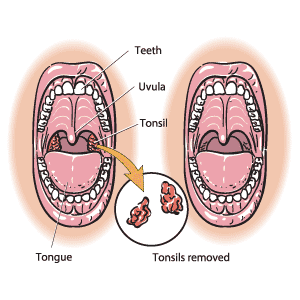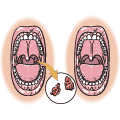Description of the procedure
Tonsillectomy is a surgical procedure to remove the tonsils. Early in life, tonsils are an important part of your immune system to help fight infections. Tonsillectomies used to be very common but are not as frequently performed today.
The procedure usually takes place in a hospital or clinic. You or your child can usually go home on the same day of the procedure.
When should this procedure be performed?
Your doctor will recommend when a tonsillectomy is required.
Why is this procedure performed?
Tonsillectomy may be performed if:
- the tonsillitis is caused by bacteria, and symptoms do not clear up with antibiotic treatment
- there are frequent infections or abscesses (more than 6 episodes of tonsillitis per year)
- the swollen tonsils block the air passages and interfere with breathing or swallowing
- a tumour on the tonsils is suspected
Are there any risks and precautions?
Certain risks are common to all surgery and anesthesia. These risks depend on many factors including the type of surgery and your own medical condition. The possible, but very rare, side effects include side effects of the anesthetic, breathing problems, infection, bleeding, scarring, and death.
The most common complication after a tonsillectomy is bleeding that can typically occur 7 to 10 days after the surgery. If you or your child experiences bleeding or any difficulty breathing, get immediate medical attention. If you or your child develops a fever, contact your doctor.
If you (or your child) are concerned about any symptoms following this procedure, speak to your doctor. Take the time to be sure you understand all the risks of complications and side effects as well as any precautions you or your doctor can take to avoid them. Be sure your doctor understands all your (and your child's) concerns.
What happens during the procedure?
General anesthesia is usually given for a tonsillectomy. You or your child will not be awake during the surgery.
The doctor removes the tonsils usually with a scalpel (a surgical knife). A special surgical tool will also be used to stop any bleeding. Once the surgery is finished, you or your child will be moved to a recovery room for monitoring until the anesthesia wears off.
The procedure takes about 20 to 60 minutes to complete.
How should I prepare for this procedure?
A physical exam as well as blood and other tests may be needed before the surgery.
Tell your doctor or prescriber about all prescription, over-the-counter (non-prescription), and herbal medications that you (or your child) are taking. Also tell them about any medication or other allergies and medical conditions that you (or your child) may have.
If a general anesthetic will be used, do not eat or drink for 8 hours before the procedure. If your doctor has recommended different times, follow the timing recommended by your doctor.
Ask your doctor or pharmacist whether you (or your child) need to stop taking any medications before the procedure.
People who have this surgery need to have someone drive them home from the hospital. Arrange for a ride in advance.
What can I expect after the procedure?
Most people go home the same day as the surgery. In rare cases, some people might stay in the hospital for 1 or 2 days.
Pain and soreness in the throat, jaw, neck, and ears occurs commonly after a tonsillectomy. Pain-relieving medications may be recommended or prescribed to help with the discomfort. Follow the instructions provided by your doctor as some pain medication can increase the risk of bleeding.
Make sure you or your child get plenty of fluids, such as water or popsicles. Cold soft foods such as ice cream, pudding, ice cubes, and cold drinks help soothe the area after the procedure. You may be instructed to avoid milk products for the first 24 hours after surgery. Other foods (e.g., hard or spicy foods) may need to be avoided during the recovery period.
Rest is essential to speed the healing process. Playing sports should be avoided for 2 weeks after surgery.
It may take up to 2 weeks to fully recover from the surgery.
Results
Your doctor will follow up with you after the procedure to see how the area is healing. It is important to know that the surgery may reduce the number of infections you have but may not eliminate them completely.
All material copyright MediResource Inc. 1996 – 2024. Terms and conditions of use. The contents herein are for informational purposes only. Always seek the advice of your physician or other qualified health provider with any questions you may have regarding a medical condition. Source: www.medbroadcast.com/procedure/getprocedure/Tonsillectomy



